Quiet Quitting- All You Need To Know About The New Trend
If you haven't been living under a rock for the last few months, you've probably heard the term "quiet quitting" being discussed, criticized and defended all over social media.
If you’re an active Tik Tok, Instagram, Twitter, or Linkedin user, you must have come across the term dozens of times. After all, the buzzword has set social media on fire and has divided the corporate world into two.
Some call it a workplace revolution. Others believe it is an excuse to avoid putting in any extra effort or going the extra mile. Somehow, most people have associated the term with laziness or lethargy. But, in reality, the concept goes much beyond this facile generalization.
So, it would be wise to delve deep and understand what this fuss is all about.
What Exactly is Quiet Quitting?
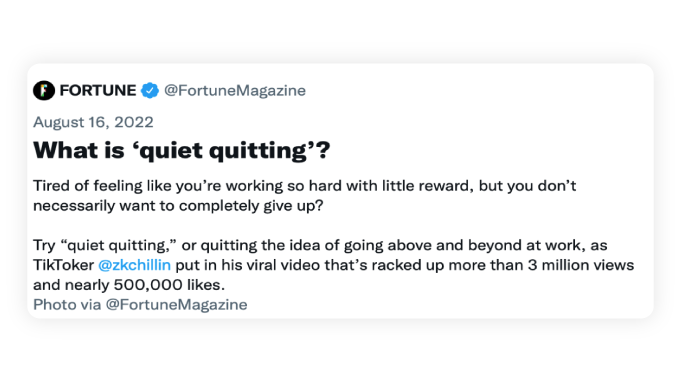
Source: Twitter
The word “Quiet Quitting” may indicate that someone is resigning from their position in an organization. But, in reality, no one is quitting their jobs. The practice of quiet quitting is a rebellion against the “hustle culture.” The very culture that glorifies long-working hours and working beyond key responsibility areas.
Quiet quitting is Gen-Z’s new way of discarding the idea of going above and beyond their job description. It advocates signing in at 9 and signing out at 5, doing only what one is hired for. And nothing more. Precisely, setting healthy boundaries at the workplace and doing the bare minimum.
Here's what Zaid Khan, a 24 year-old engineer from New-York who is credited with popularizing the concept stated:
Quiet quitting is where you’re not outright quitting your job, but you’re quitting the idea of going above and beyond. You’re still performing your duties, but you’re no longer subscribing to the hustle culture mentality that work has to be your life.
Is quiet quitting for real?
Adrienne Couch, a Human Resource Analyst at LLC. Services said:
Quiet quitting does exist, and it is real in the workplace.
Her statement is not far off from the truth.
As Gallup finds, 50% of the U.S workforce consists of “quite quitters.” A figure this high indicates that the practice is widespread. The same Gallup study highlighted some interesting findings such as:

Various data indicate that quiet quitting is more real and pervasive in today’s corporate scenario. But many experts argue that this practice has always been there. Quiet quitting is just a new term for an age-old behavior.
After all, the corporate world always had its share of quiet quitters. Employees who believed in setting boundaries and avoiding unnecessary workload. In short, pro bono has never been their cup of tea.
But why the concept of quiet quitting has gained momentum now? Is it because of a paradigm shift in perception? Or is it because of a massive work-culture change post-pandemic?
And why do young working professionals mostly adopt the trend?
Let’s find out.
Why is Gen-Z Considering Quiet Quitting?

The hashtag #quiet_quittting has garnered millions of views on Tik Tok. Everyone in the corporate circle is talking about it. The cacophony of it has spread on other social media platforms as well.
But why are the young workers so interested in this concept? And why are ‘they’ contemplating quiet quitting?
Well, it’s a known fact that GenZers value work-life balance and great quality of life in toto. They deeply care about issues such as:
- Security
- Stability
- Physical and mental well-being and,
- Social connections.
The significance of these issues amongst the youth has gained immense traction post-pandemic. Even a 2022 Edelman Trust Barometer survey highlights that:
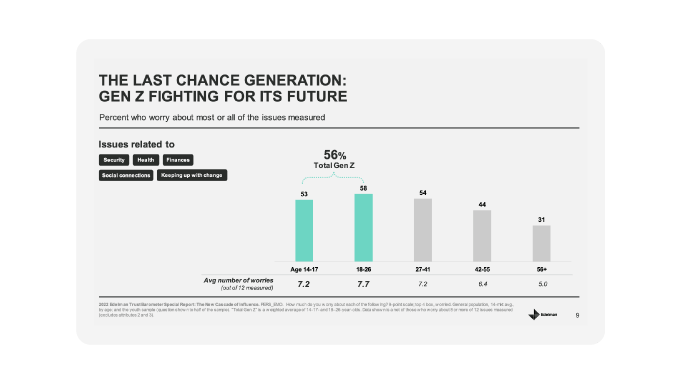
Moreover, the disarming effects of the pandemic have taken a toll on the mental health of young workers. As a 2021 Global Risk Report finds, 80% of young people worldwide are vulnerable to depression, anxiety, and disappointment.
Another survey conducted by Indeed in 2021 showed:
Millennials and Gen Z workers reported the highest rates of burnout at 59% and 58%, respectively.
The rate at which young professionals experience burnout so early on in their careers is alarming. Such persistent stress could be a reason for them to demand change.
Ojaswini Sapatnekar, Head of People Strategy at Intangles Lab Pvt. Ltd has shared something noteworthy. She believes that:
Quiet quitting is a cry for help because if somebody going beyond the call of duty has stopped demonstrating their behavior, it is an indicator that the person is questioning their previous behavior. Moreover, the person is not getting the right motivation on a daily basis.
Thus, the youth is focusing on devising strategies to cope with lack of motivation, stress and strike a better work-life balance. For them, the prospect of setting healthy boundaries and doing the bare minimum is appealing. In other words, young workers have started viewing quiet-quitting as respite.
Here, do know that employees don’t jump into this practice the very next day they hear about it. The shift to that mindset is characterized by a gradual withdrawal from extra and thankless responsibilities.
But while undergoing this transition, quiet quitters exhibit quite a few signs. Signs that indicate employee’s disengagement or lack of enthusiasm.
Identifying those signs or characteristics is integral to avoid the trend in your organization.
Tell-tale Signs of Quite Quitting
Quite quitting is made easier in the hybrid or remote work model as it’s easier to hide. Quite quitters are managing only to the minimum set of performance expectations.
~ Joe Galvin, Chief Research Officer at Vistage Worldwide
Although quite quitting is inconspicuous, few tell-tale signs indicate people who have jumped on the quiet quitter’s bandwagon.
Joe Galvin, CRO at Vistage Worldwide, highlights some key signs or characteristics in a Forbes article. If you want to find out potential quiet quitters, look for the signs below-
-
Disengagement on a chronic basis.
-
Performance only to the minimum set of performance standards.
-
Isolation from other members of the team.
-
Withdrawal from any non-necessary conversations, activities, or tasks.
-
Attendance at meetings but not speaking up or taking action.
-
Teammates report a sudden increase in their workload in picking up the slack.
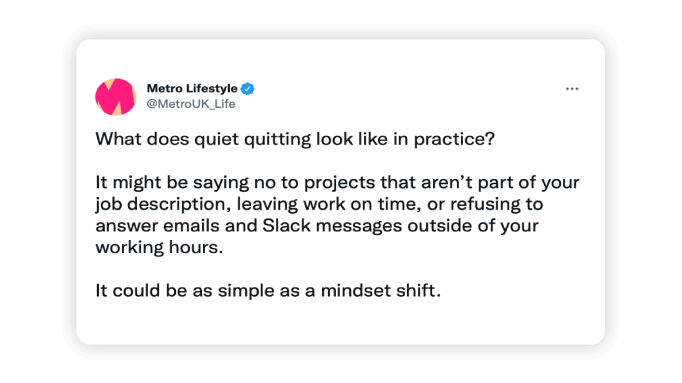
Source: Twitter
If you notice these signs in your employees, one of the major causes could be that the current work culture bothers or does not work for them. They are looking for ways to improve the quality of their personal and professional fronts. Trends such as quiet quitting are helping them achieve that much-needed work-life balance.
Quiet quitting isn't necessarily a bad thing. However, it does have some flaws that cannot be overlooked. It is critical to analyze and address these drawbacks in order to understand how to reduce their occurence.
But before we address them, let us try to understand why employees go down this path. Without understanding their motives, you be unable to help them or create any difference in their perspective.
Exhibiting the above signs does not indicate that employees are not doing their job or deliberately doing less. Rather, they are focused on doing what they are paid for. At the same time, avoiding tasks beyond their job description.
After getting hold of the meaning and signs of quiet quitting. It is time to identify and analyze the reasons behind the movement.
So, here are the primary causes that have led the concept into a trending silent war.
6 Primary Reasons Behind Quiet Quitting
1. The Pandemic
No wonder there is a paradigm shift after Covid-19. After all, the pandemic has bought us face to face with mortality. It has forced us to re-evaluate our priorities. It has made us question the things we invest our time in. In other words, we are undergoing a “great reflection.”
The work and work environment is where the reflection takes place the most. As Gartner’s report points out:
The intent to leave or stay in a job is only one thing that people are now questioning as part of our larger human story. You could call it the “great reflection.”
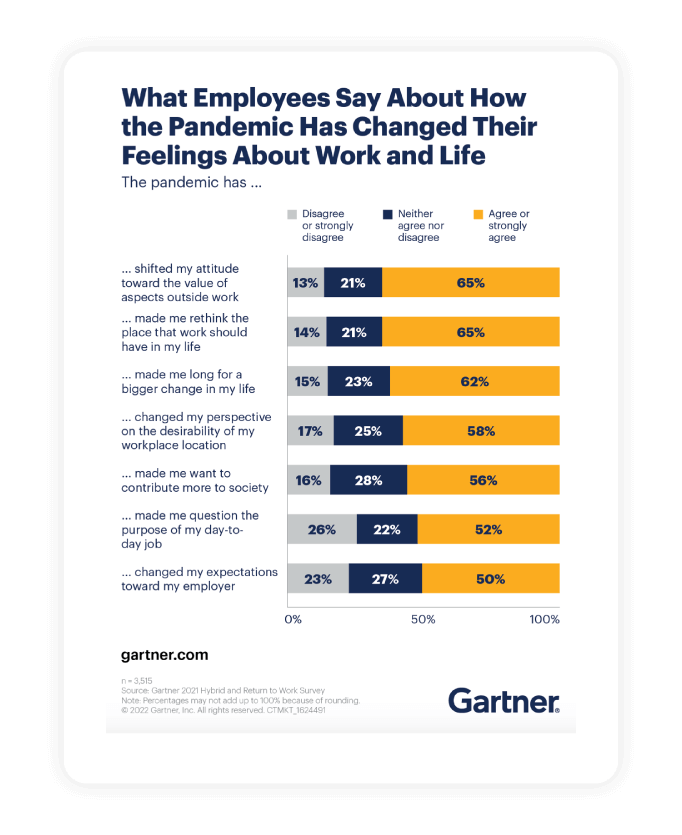
The so-called quiet quitting is one of the consequences of great reflection. People of late, have felt the need to reconsider their way of working. They somehow wished to adopt a workstyle that provides a good quality of life but with limited engagement, effort, and commitment.
The new trend of quietly giving up serves its purpose.
2. Remote Work Setup

The shift to the remote working model during the pandemic profoundly impacted employees. Their view on when, where, and how they want to work has changed.
As Tsedal Neeley, a professor at Harvard Business School, states:
We have changed. Work has changed. The way we think about time and space has changed. Workers now crave the flexibility given to them in the pandemic. Something which had previously been unattainable.
The remote working model has garnered immense traction post the nationwide lockdown. And ever since, its popularity has been on the rise. But although hybrid or remote working culture is highly popular and preferred, many experts believe it comes with shortcomings too. Some of the unique set of challenges it poses are:
Rise in burnout due to prolonged working hours and lack of boundaries during the remote work stint. It has resulted in a constant need to deviate from the monotonous work-life and toxic culture.
Remote working has allowed employees to slack off unnoticed. An issue underscored in an article by Korn Ferry - On the Job, Off the Clock.
Experiencing novel concepts that helped balance work and life. Such as virtual meetings, Friday off, flexible work hours, and more. After experiencing the benefits of these concepts, employees don’t wish to give up these luxuries. They feel a loss of freedom when asked to return to traditional working methods.
3. Inadequate Compensation
According to an analysis of Payscale’s crowdsourced salary data,
49 percent of the workers are underpaid.
And this is not good for the employees, employers, and the market at large.
After all, it goes without saying that paycheck matters. A fair paycheck holds tremendous value. The goal of employee satisfaction is unattainable without competitive salary and benefits. Also, fair compensation says, "I respect and value your efforts." It adds meaning to the work that your people do. Frankly, it is non-negotiable when it comes to employee engagement.
When employees are provided with fair and competitive pay, they stay.
Compensation, apart from cash, is also valuable. Policies such as additional paid time-off hours, gift coupons, stock options, etc,. can be equally meaningful.
But if employees feel they’re underpaid, they lose motivation and the willingness to step up at work. Their urge to achieve or overachieve targets may get shattered. In such cases, trends like quiet quitting may seem a better option for them as it allows and justifies reduced effort, enthusiasm and engagement.
4. Lack of Career Advancement

Did you know that one of the top reasons behind the “great attrition” was the lack of career development?
A survey conducted by McKinsey & Company also confirms the same.
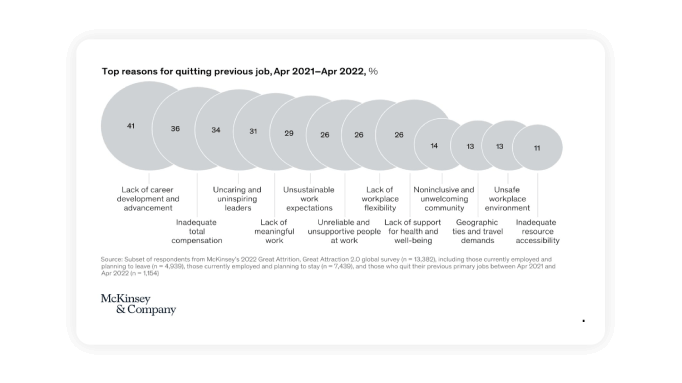
But did you know that lack of career progression could also be the driving force behind quiet quitting? After all, why take the pain to go above and beyond at work without visible career progress?
Career advancement is way more important now than it has ever been. The world is becoming more uncertain day by day. Consistent and relevant skill training is necessary for employees to secure their career paths. Unless companies enable that, employees lose the will and determination to perform above expectations at work.
Eventually, employees’s dissatisfaction with their career progression is expressed through passive-aggressive behaviors such as quiet quitting.
HR leaders must pay close attention to employee dissatisfaction with career development to prevent drops in workplace effort and employee attrition.
~ Gartner
Even Ojaswini Sapatnekar is of the opinion that leaders should know who are the top talent of their organization. And if any quiet quitting behavior is observed, leaders must communicate that the organization views them as talented. Leaders should have progressive plans for that person to grow within the organization.
5. Toxic Work Environment
No one on earth would feel like giving their best in a toxic work environment. Let alone talented professional minds. The toxic environment is one of the worst places to be in. And employees would give their all to avoid it.
After all, toxic work cultures cause discrepancies in life. It adversely disrupts physical and mental
well-being. Apart from a physical and mental breakdown, it also:
- Creates conflict
- Increases employee turnover rate
- Increases employee absenteeism
- Promote abusive behavior among employees
- Reduce morale and workplace positivity
To tackle such workplace toxicity, it's important to get to the root of the cause. Here are some (un)popular reasons leading to a toxic work culture:
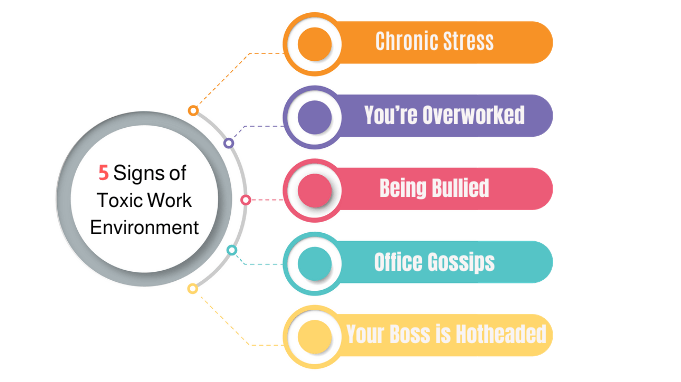
Toxic work cultures can lead to employees not being willing to take up more responsibilities. It may make employees feel dissatisfied, disengaged, and unproductive. Such experiences can ultimately encourage employees to adopt the concept of quiet quitting.
Recommended Resource: Hostile Work Environment- Everything You Need To Know
6. Bad Managers

Are you intending to quiet quit? If "yes", what made you arrive at that conclusion.
Is it because of “bad” or ineffective managers?
Well, nobody would be shocked to learn that the reason for your quiet quitting is that you are under the control of a toxic and terrible manager.
After all, several data indicate that quiet quitting is less about an employees' unwillingness to work hard and more about a manager’s failure to build a strong relationship with their employees.
Even Harvard Business Review, in its recent article, stated that:
The least effective managers have three to four times as many people who fall in the quiet quitting category compared to the most effective leaders.
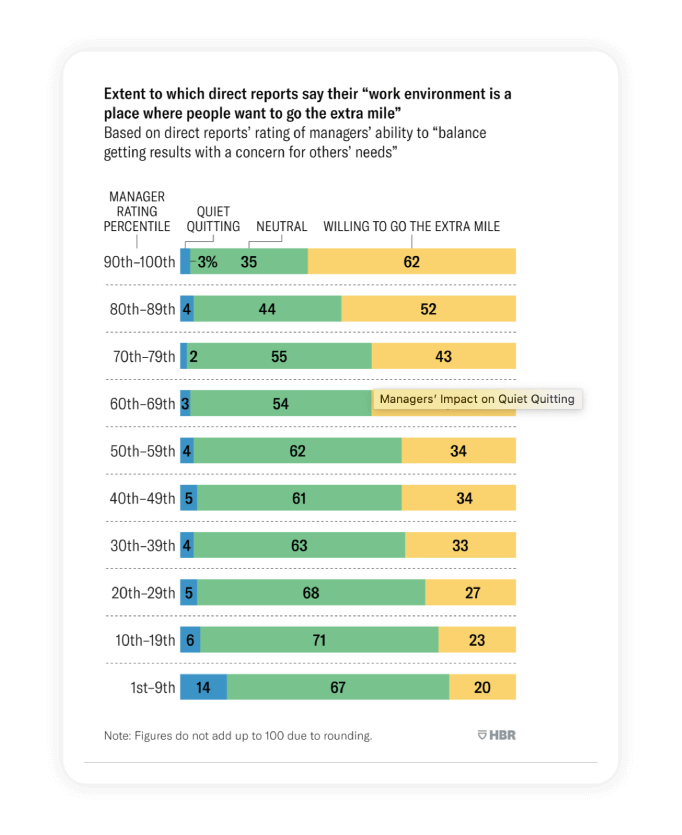
Source: A Zenger Folkman analysis published in an article by Harvard Business Review.
It is a common adage that ineffective managers do not influence employees. They can neither inspire nor motivate. They can only supervise employees to get the minimum work done in their managerial position.
In such an uninspiring culture, expecting employees to over-perform or surpass their key responsibility would be unrealistic.
What are the Ways to Combat Quiet Quitting?
Quiet quitting is as detrimental to your organization as outright quitting. So as an HR, if your focus is on increasing employee retention. You also have to lay emphasis on encouraging employees not to become quite quitters.
After all, disengaged workers will cost your organization heavily. As it has cost the global economy $7.8 trillion in lost productivity, according to Gallup.
Thus, it is imperative to analyze and come up with ways to motivate and encourage employees. At the same time, let them know that their efforts matter. And their contributions make a huge difference.
So, here are some ways for all Employers and HR professionals to consider resolving the issue of quiet quitting.
1. Humanize Work
Rather than thinking of burned-out people as “quiet quitters” who are somehow cheating you out of their fullest capacity for productivity, consider that you might be cheating them out of a healthy, human-centered work environment.
~Forbes
Humanize the work. Humanize the working environment.
It is a simple yet effective way to encourage employees.
In today’s day and age, a human dimension to work is potent. It is a way to show employees that companies are equally invested in them as they are. It is a potential way to make them feel valued.
Introducing a humanistic approach to the workplace is crucial for organizational success. But balancing the humane side with the ongoing digital transformation is especially crucial. Here, it is worth sharing Deloitte’s strategy for humanizing work. And they are:
-
Re- architect work - Redefining future work using technology to elevate human capabilities.
-
Unleash the workforce - Challenge the way we perceive the workforce. And use technology to unleash human potential within the organization and beyond.
-
Adapt the workplace- Respect for the organization and cultural shifts that are demanded.
Organizations will have to illustrate and emphasize inclusion, engagement, and benefits. They have to develop a strategic focus on the work and working culture. When they’ll be successful in implementing such a culture, employee engagement and satisfaction will get a boost.
2. Look for Job and Culture Fit

If you hire people because they can do a job, they’ll work for your money. But if you hire people because they believe what you believe, they’ll work for you with blood, and sweat and tears.
~Simon Sinek
One of the HR practitiones' key responsibilities is finding people who are a good fit for the job and the organization.
Finding a good cultural fit entails looking for someone who shares the company's values and mission. They will have similar goals and outlooks as the organization. Ideally, they will also be extremely passionate about the work they will overtake.
Hiring a culture fit is a crucial employee retention strategy. Apart from increasing employee retention, it can greatly benefit the organization in other aspects as well. Some of the key benefits it offers are:
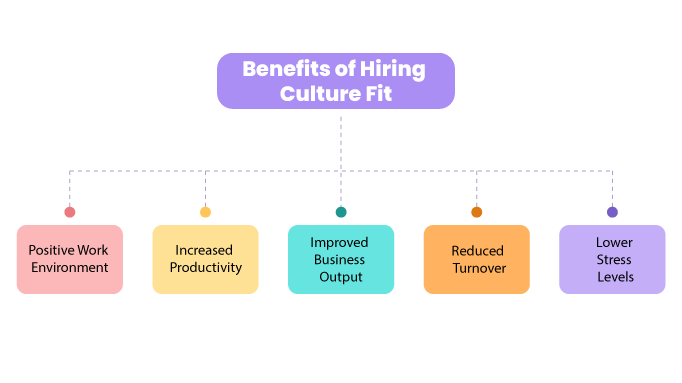
But it is no easy task to find someone suitable for your organization’s culture. A lot of effort and strategies are required to find that one candidate. Without having a sound understanding of the hiring strategies, you may end up recruiting someone unfit for the role and culture.
That makes identifying the strategies indispensable. But now you may be wondering about the ways to find cultural fits. Below are some of the key strategies for find and hiring apt candidates:
- Clearly communicate your company cultures and values.
- While conducting interviews, ask questions relevant to the values you’re searching for.
- Properly design and implement pre-employment assessments.
- Define the job role appropriately. And evaluate whether they’re passionate about the role or not.
3. Foster a Culture of Rewards and Recognition

Think about the last time you were appreciated for accomplishing a task. How did you feel?
Didn’t you feel valued and recognized? And most of all, proud of yourself.
You surely must have felt amazing. Right!
After all, recognition is one of the most incredible ways to make someone feel special. The simple act of being praised has an impeccable impact. It boosts morale and motivates employees to fine-tune their performance standards.
But the practice of recognizing efforts is all the way more important in the corporate world. And there is ample research to back its potential. Some of the most significant studies conducted on employee recognition benefits are:

Sources:(HR Technologist, Gartner, Globoforce, OGO, Achievers, Glassdoor)
But simply congratulating or verbally acknowledging hard-working employees is not enough. Recognition shall be carried out in a manner that adds value to their careers. It must accelerate professional growth and enhance their goodwill.
Vantage Rewards one of the best SaaS solutions to help you design a culture of appreciation through deep integrations, dedicated apps, and multi-platform support. To learn more about Vantage Rewards, click here for a free demo.
With an aim to help organizations automate and transform their R&R programs, Vantage Rewards offers some incredible features such as:
- Fast and Instant Recognition
- Peer-to-peer Appreciation
- Data-driven Insights
- Multiple HR Systems
- Public Platform for Recognition
- Service Yearbook
Recommended Resource: The Ultimate Guide to Employee Reward and Recognition
4. Offer Work-life Balance

Forbes Health Ipsos Health Tracker surveyed 1,120 US adults and discovered that:
90% of the 620 current employed respondents said work-life balance is an important aspect of their job.
More and more professionals are demanding better work-life balance. After all, a healthy work-life synergy is what helps employees prioritize things that matters. In the longer run, it also assists them in creating a more sustainable and fulfilling way of living life.
Employers must realize that healthy work-life balance is more about the quality of work rather than the quantity of hours employees put in. It is about cultivating a healthy work environment where the workplace feels like a safe place that encourages creativity, boundaries, and allows the flexibility to work when people feel the most productive.
Thus, employers and HR practitioners must prioritize implementing employee-centric policies and support programs. Ideally, these policies would involve both credible employees and the C-suite level in decision making. It helps everyone get on the same page regarding the policies’ expectations and goals.
5. Promote a Culture of Learning and Development

The ultimate mantra for corporate success is developing one's talents and skills. And the workforce knows this mantra all too well. That’s why the modern employee is more likely to seek out cultures that have the potential to further their growth and skills. If they discover a culture lacking in robust talent development initiatives, they quickly lose faith in the organization.
That makes it imperative for employers to invest in training and development policies. Programs that focus on developing the skills and talents of individuals. Moreover, it also unlocks infinite future opportunities for career-minded employees. Here, a Gallup study points out that:
Companies that invest strategically in employee development are twice as likely to retain their people while increasing profitability by 11%.
In its latest article, Forbes shares some best practices for using learning to engage, inspire and retain talents, such as:
- Let learners decide what to learn
- Involve teams
- Provide time for learning
- Connect learning to your organization's core beliefs
- Prioritize soft skills
Moreover, Ojaswini Sapatnekar has advised employers to encourage open-ended communication within the organization. So, they are open enough and transparent and come on their own and share what they are doing beyond work life. Employees' lives beyond the workspace should not be treated as a black box.
6. Practice Pay Communication
According to Payscale’s data,
51% of workers believed that they were underpaid. But, in reality, they were paid at or above the market.

Source: Payscale
Many employees have no idea whether they’re being paid fairly and competitively. With each passing day, the perception of fair pay is getting worse. Employers are not communicating, and employees are presuming.
Due to rising confusion, employees don’t know whether they are valued properly or not. Also, the chances of them feeling underpaid is more. Feeling underpaid or less valued may ultimately lead to reduced efforts and increased boundaries at work on their part.
In such a scenario, pay communication becomes indispensable.
Payscale defines pay communication as the organizational practice that determines how pay information is shared and communicated to current and prospective employees.
Communicating with the employees on the pay policies is necessary to maintain transparency and clear any skeptics. Moreover, it strengthens employee engagement and reinforces company culture. It also enhances the perception of employers and HRs in the minds of employees.
Bottom Line
On the surface, quiet quitting may seem to be the ultimate motto for a stress-free life. It may sound like the most sustainable way to work. But, in reality, it may have its downsides. After all, there is a difference between setting healthy boundaries and being disengaged.
It is healthy to set some boundaries to maintain a work-life balance. But it is unhealthy to have zero enthusiasm for work. It is healthy to discard the idea of overworking. But unhealthy to be non-flexible about taking up additional responsibilities.
At the same time, it is imperative to know that quiet quitting is an employee’s response. It is a form of retaliation against toxic work cultures and redundant employee engagement policies.
So, it is time to re-evaluate and rebuild the existing work cultures. Efforts must be directed towards fostering a work environment that respects the work-life boundaries set by the employees. But concurrently motivates them to give their best and occasionally outperform at their workplaces.


















